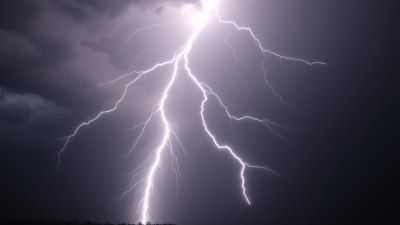What Causes a Storm to Fizzle Out
Explore the scientific factors that lead storms to weaken and dissipate before they reach full intensity.

Storms are powerful atmospheric phenomena that can dramatically impact the environment and human activities. However, not every storm reaches its full potential, and many fizzle out before causing significant effects. Understanding why storms weaken involves a combination of meteorological principles, atmospheric conditions, and environmental interactions. This article delves into the factors that can cause storms to lose their strength and dissipate.
1. Lack of Moisture
One primary reason storms fail to achieve their potential is a lack of moisture in the atmosphere. Storms draw their energy from warm, moist air. When this moisture supply is inadequate, it limits the storm's ability to produce heavy precipitation and maintain its intensity. For instance, if dry air enters the storm system, it can disrupt cloud formation and reduce rainfall, causing the storm to weaken.
2. Changes in Wind Patterns
The wind direction and speed at various altitudes significantly affect storm development. A phenomenon known as wind shear occurs when there is a significant difference in wind speed or direction between the surface and upper levels of the atmosphere. High wind shear can tilt a storm, preventing it from organizing effectively and leading to its dissipation. When the storm's circulation is disrupted by shifting winds, it struggles to consolidate and may ultimately fizzle out.
3. Temperature Inversions
Temperature inversions occur when a layer of warm air traps cooler air below it. This scenario can inhibit the vertical development of storms by preventing warm air from rising and forming clouds. If a storm encounters a temperature inversion, its strength can diminish as the necessary lifting mechanism is restricted. Elevated warm layers can cap the storm's ability to develop further and lead to its gradual decline.
4. Drier Air Entrapment
Sometimes, surrounding air conditions can affect a storm's intensity. If drier air from surrounding regions becomes entrained into the storm, it can weaken the updrafts necessary for storm development. This process can dry out the cloud bases, leading to reduced precipitation and ultimately causing the storm to fizzle before reaching its full potential.
5. Land Interaction
Storms that move over land face additional challenges that can lead to their weakening. Unlike oceans, which provide a consistent supply of moisture and energy, land's rough terrain and varied surface conditions can disrupt storm organization. When a storm makes landfall, it often loses access to warm, moist air, leading to a rapid decline in intensity. Furthermore, the friction experienced over land can decrease the storm's wind speeds and disrupt its structure.
6. Cooler Surface Temperatures
Another factor contributing to storm dissipation is cooler ocean surface temperatures. For tropical storms and hurricanes, warm ocean waters act as the fuel that powers these systems. If a storm moves over cooler waters, its energy supply diminishes, leading to a loss of momentum and strength. This principle applies not only to ocean-based storms but also to any weather system dependent on warm surfaces for energy.
7. Vertical Wind Shear
Vertical wind shear plays a significant role in storm development and dissipation. When a storm experiences significant variations in wind speed or direction with height, the structure of the storm can become compromised. Such shear can disrupt the organization of the storm's lazy spirals and reduce its capacity for precipitation accumulation. If the upper-level winds are too strong and continually break apart the organized flow of the storm, it can lead to a loss of coherence and eventual fizzling out.
8. Interaction with Other Weather Systems
Storms do not exist in isolation; they interact with other weather systems within the atmosphere. When a storm moves into a region already occupied by another weather system, especially if it is a more dominant system, it may lose its structure and energy. Such interactions can lead to the merging of systems, which can diminish the strength of the original storm as it gets absorbed into a larger weather pattern.
9. Difficulty in Sustaining Thunderstorm Activity
In the case of thunderstorms, the ability to maintain active updrafts is critical for their longevity. If a thunderstorm cannot continue to generate new updrafts—due to the cooling of surface temperatures, a lack of uplift, or disruptions in its environment—it lacks the necessary components to sustain itself. The life cycle of a thunderstorm can be relatively short, frequently lasting only a few hours unless external conditions support its growth.
10. Seasonal Influences
Seasonal changes can significantly influence the lifecycle of storms. Certain times of the year are more conducive to storm development, while others can lead to rapid weakening. For example, in the tropics, the peak of hurricane season is characterized by warmer ocean temperatures and favorable wind patterns. Conversely, as temperatures decrease during fall and winter months, storms are more prone to fizzling out due to cooler conditions and changes in atmospheric stabilization.
11. Pollution and Urban Heat Islands
Human activities can influence storm dynamics in unexpected ways. Urban areas produce significant amounts of heat and pollution, creating localized atmospheric conditions that can interfere with storms. While these factors can sometimes enhance local storm activity via the urban heat island effect, they can also disrupt the larger-scale conditions necessary for formation and sustainment, ultimately leading to storms that may weaken rather than intensify.
12. Atmospheric Instability
The overall stability of the atmosphere significantly determines whether storms will flourish or dissipate. An unstable atmosphere allows for strong updrafts and storm development, while a stable atmosphere inhibits vertical motion and storm growth. Various factors, like subsidence and inversion layers, can create a more stable environment, reducing the likelihood of significant storm development and leading to early dissipation.
In summary, storms can fizzle out due to various interconnected meteorological factors including moisture availability, wind patterns, temperature inversions, and land interactions. Understanding these dynamics is crucial for meteorologists to predict storm behavior and assess potential impacts. While storms are awe-inspiring and essential components of Earth's weather system, their unpredictability remains a topic of ongoing research and fascination.











